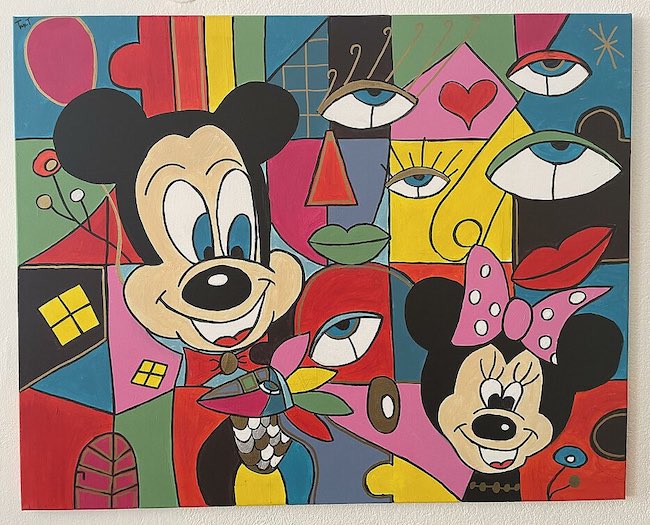Il mondo della fiaba, dei cartoni animati, evoca l’immaginario di tutte quelle persone che sono state giovani nella seconda metà del secolo scorso, lasciando un segno indelebile nella memoria di un periodo sereno, innocente, dove tutto ciò di cui urgeva preoccuparsi era di crescere senza dimenticare mai le basi e i valori con cui si era cresciuti. Alcuni artisti nel passato come nel presente, prendono spunto da quegli universi fantasiosi che hanno il potere di far sentire l’osservatore coinvolto proprio per la semplicità di linguaggio espressivo e anche per il fatto di fare riferimento a soggetti popolari che li riporta indietro nel tempo. E poi ci sono quei creativi che, pur scegliendo questo tipo di approccio semplice e pieno di riferimenti fumettistici e favolistici, personalizzano stili nati originariamente con tutt’altra intenzione, stabilendo nuove connessioni tra semplicità e intellettualismo; la protagonista di oggi rientra in questa categoria.
L’approccio artistico alla realtà osservata è stato completamente stravolto dalle innovazioni di fine Ottocento e inizi Novecento, quando l’armonia estetica, l’utilizzo dei colori, l’esistenza della prospettiva vennero oltrepassate da un modo diverso di dipinge e di rapportarsi alla tela. Il tema della scomposizione fu già anticipato dall’Impressionismo ma poi approfondito dal Divisionismo e ampliato ed enfatizzato con il Cubismo e il Futurismo e infine completamente estremizzato con l’Astrattismo, in particolar modo quello Geometrico. Ma laddove i movimenti di rinuncia alla forma conosciuta compirono un distacco totale dall’osservato, il Cubismo invece mantenne il legame con la figurazione, sebbene stravolta da quella suddivisione geometrica attraverso la quale i suoi maggiori esponenti, Pablo Picasso e Georges Braque, analizzavano in maniera quasi scientifica la realtà osservata, la possibilità di annullare la prospettiva presentando un’osservazione contemporanea dei diversi livelli e angolazioni dando un senso di contemporaneità degli accadimenti o delle sfaccettature delle figure protagoniste. Le loro opere risultavano pertanto intellettuali, per quanto riguardava l’approccio esecutivo, ma al tempo stesso in grado di attrarre e incuriosire anche un pubblico poco colto, come nel caso delle grandi e immortali opere di Picasso. Qualche anno dopo invece, intorno alla metà degli anni Cinquanta del Novecento, venne compiuto invece un importante passo verso quella borghesia emergente che stava sempre più dettando le regole del vivere grazie alla sua capacità economica, che però non aveva avuto un’istruzione adeguata a comprendere l’arte intesa nel senso più alto del termine, pur essendo sensibile alla bellezza; dunque Andy Warhol, padre della Pop Art, scelse di adottare un linguaggio artistico che contenesse riferimenti alle icone del cinema e ai beni di consumo che appartenevano alla quotidianità della cosiddetta classe media che si interessò dunque, proprio per la possibilità di comprenderne il messaggio artistico, all’acquisto di opere prodotte serigraficamente, dunque senza i costi elevati di un’opera unica altrimenti inaccessibile ai più. Le tonalità vivaci e intense, frutto di un’inclusione dell’utilizzo cromatico espressionista, facevano da cornice a immagini decontestualizzate di personaggi di primo piano come Marylin Monroe ed Elisabeth Taylor, nelle opere di Andy Warhol, o ai personaggi dei fumetti di Roy Lichtenstein e di Steve Kaufman.
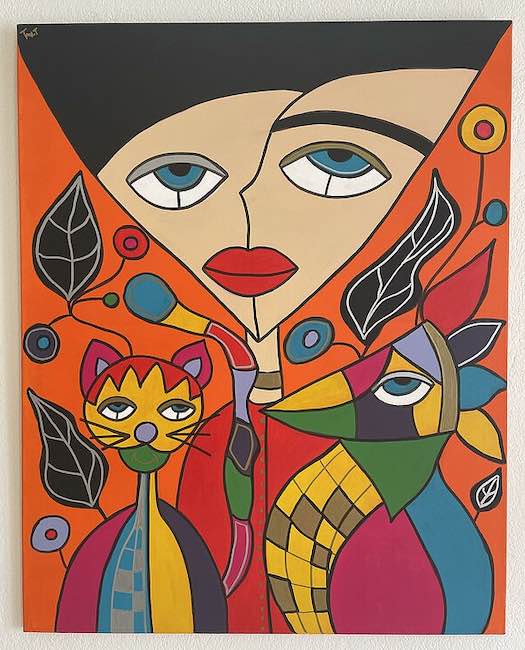
L’artista ungherese Tünde Wagner, da molti anni residente in Austria, unisce e mescola in maniera inedita il Cubismo alla Pop Art senza tralasciare alcune caratteristiche dell’Espressionismo, dando così un’impronta del tutto personale a opere pittoriche in cui racconta non solo il suo modo giocoso di osservare il mondo, bensì mette anche in evidenza quelle nuove icone che hanno costituito per lei degli importanti passi conoscitivi e di passaggio dall’essere fanciulla allo stato di adulta con la necessità di mantenere il contatto con il proprio lato bambino.
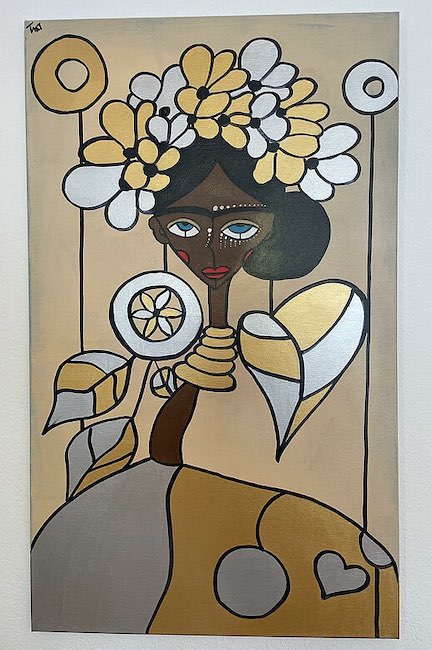
Dunque la serietà del Cubismo originario, l’approccio serioso e quasi scientifico che diveniva filtro con cui Picasso guardava e riproduceva la realtà, diviene con Tünde Wagner decisamente più irriverente, ma soprattutto divertente e concentrato su un mondo fantasioso, fatto di personaggi dei fumetti, dei cartoni animati o di icone che per lei hanno un significato particolare; la scelta cromatica ricade su tonalità intense, piene, esuberanti, come se per lei la vita fosse un meraviglioso percorso da affrontare con tutta la positività e l’allegria che scaturisce dal saperla guardare con il punto di vista migliore, quello del sorriso. I personaggi sono molto spesso affiancati dal mondo animale che riesce a infondere alle sue opere quel misto di spontaneità e ingenuità appartenente da sempre a tutti quegli amici che arricchiscono la vita degli esseri umani e che ne vivacizzano la quotidianità, mentre i contorni sono sempre netti e ben definiti secondo le linee guida dell’Espressionismo, perché quelle tonalità dirompenti e vivaci hanno bisogno di essere contenute, di essere definite e stilizzate nel loro risultato finale.
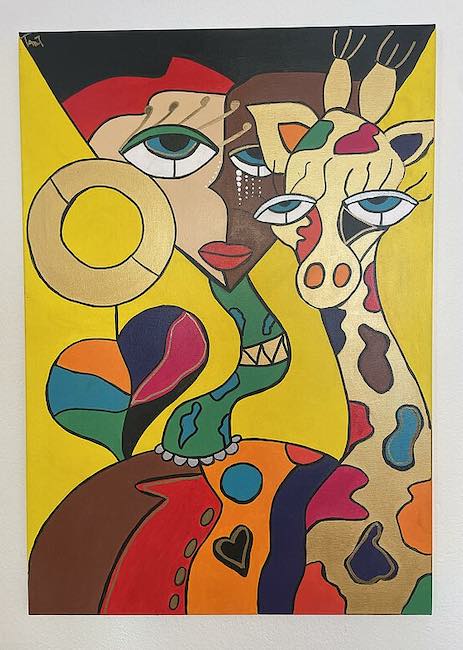
Il lato Pop di Tünde Wagner emerge con personaggi simpatici e simbolo di un’epoca come Mickey Mouse e Pippi Calzelunghe, ma anche di un protagonista meno conosciuto dei cartoni animati come la giraffa Lilli, appartenente alla cultura tedesca e austriaca; non solo, una delle icone che l’artista preferisce raccontare è un’altra artista, Frida Kahlo, con cui ha in comune un incidente che le ha impedito di seguire il suo sogno di diventare ballerina permettendole però di incontrare la pittura che è divenuta la sua manifestazione artistica in virtù della quale ha potuto superare l’ostacolo trovando una nuova strada.
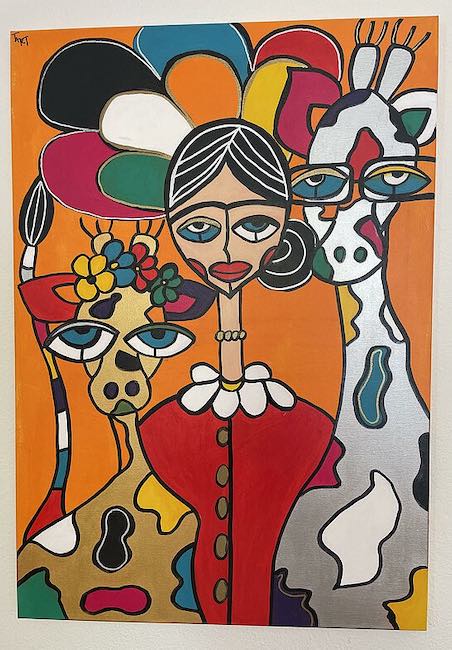
Ecco dunque che la grande pittrice surrealista diviene prima attrice dell’opera Elilli and Frida, che Tünde Wagner ambienta in un mondo surreale costituito dalle giraffe amate dai bambini austriaci che guardano verso il fruitore insieme a Frida Kahlo, come se fossero stupite e al tempo stesso concentrate a capire il perché la loro realtà sia tanto differente da quella che hanno davanti; in fondo il mondo fiabesco che dipinge l’artista è qualcosa che ciascun adulto racchiude dentro di sé come se costituisse un rifugio alla contingenza in cui tutto è più bello, sereno, colorato, esattamente come le immagini che riempiono le sue tele.
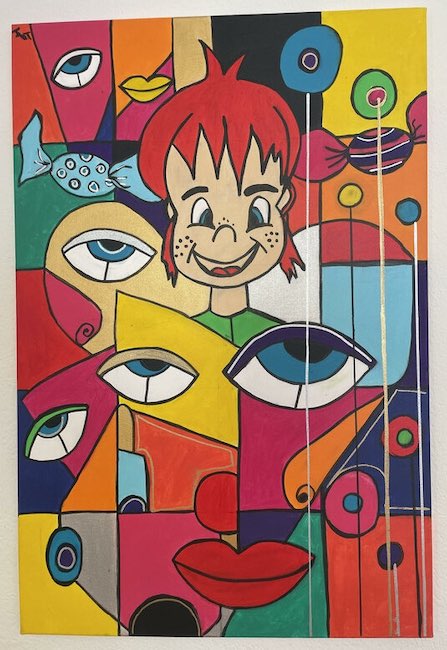
Nel dipinto Pippi evoca la bambina ingestibile e un po’ magica che ha allietato l’infanzia dei bambini degli anni Ottanta e che viene posta al centro della composizione circondata da caramelle, dagli sguardi delle persone che la giudicavano senza conoscerla solo per le sue stranezze, le stesse persone che lei, con la sua forza di carattere, ha sempre scelto di ignorare. Questa opera sembra essere un invito all’uomo contemporaneo di non lasciarsi influenzare dal giudizio degli altri, come se l’artista conoscesse l’importanza della forza interiore e dell’autostima e invitasse l’osservatore a non esitare e a seguire solo il proprio cuore, i propri desideri anche se ostacolati dagli altri, anche se ritenuti irrealizzabili, anche se catalogati come strani. Probabilmente anche in questo caso emerge la storia personale di Tünde Wagner che inevitabilmente traspare come messaggio nascosto in ciascuno dei suoi dipinti. In questa e in altre tele il suo stile presenta un’attitudine verso il Surrealismo per la presenza quasi invadente di occhi, sguardi che sembrano esprimere differenti emozioni, dunque forse appartenenti alla stessa interiorità che si pone in ascolto, ma anche in discussione, lasciando emergere tutto ciò che le parole non riescono a dire, oppure gli occhi sono esterni, quelli della società in cui ciascun individuo vive e che appartengono inevitabilmente a differenti approcci all’esistenza, a caratteristiche personali diverse, a modi di pensare persino opposti talvolta, eppure altrettanto attendibili e possibili quanto i propri.

Il dipinto Hourglass trasforma la clessidra, protagonista del titolo, in una rappresentazione della presa di coscienza dello scorrere del tempo, dell’importanza di cogliere ogni attimo che altrimenti fuggirebbe inesorabilmente via, del rimpianto di non aver saputo comprendere l’entità di una circostanza nel momento in cui si è presentata e della nostalgia di ciò che invece, pur avendolo voluto fortemente, si è allontanato. Il tocco giocoso della pittura di Tünde Wagner non riesce ad affievolire l’intensità del messaggio di questa opera che evoca nell’osservatore la contezza che tutto può scomparire improvvisamente dalla vita e perciò è meglio assaporare e vivere piuttosto che perdersi in esitazioni o parole che di fatto paralizzano l’azione.
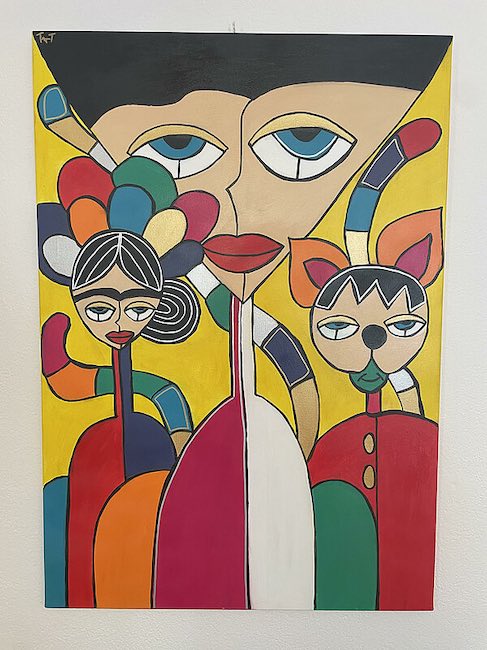
Tünde Wagner si è formata come autodidatta, e il suo stile ha subìto una forte personalizzazione dopo un incidente che le ha impedito di perseguire l’altro suo sogno, quello di essere una ballerina; questo le ha permesso di far esplodere una grande forza interiore per superare l’ostacolo, che si svela nel suo stile personale e originale grazie al quale è stata notata nelle mostre collettive internazionali a cui ha preso parte in Austria e in Italia attraendo l’attenzione dei collezionisti e degli addetti ai lavori.
TÜNDE FULEKI WAGNER-CONTATTI
Email: tuende.w@gmail.com
Sito web: https://www.burgenland.at/service/plattform-fuer-kunstschaffende-im-burgenland/kuenstler-detail/tuende-wagner/
Facebook: https://www.facebook.com/tundefuleki.wagner
Instagram: https://www.instagram.com/tundefuleki.wagner/
Playful irony in the artworks of Tünde Wagner, between Neo-Cubism and Expressionism with a Pop touch
The world of fairy tales, of cartoons, evokes the imagination of all those people who were young in the second half of the last century, leaving an indelible mark in the memory of a serene, innocent time, where all one had to worry about was growing up without ever forgetting the foundations and values with which one had grown up. Some artists, in the past as in the present, take their cue from those imaginative universes that have the power to make the observer feel involved precisely because of the simplicity of their expressive language and also the fact that they refer to popular subjects that take them back in time. And then there are those creatives who, while choosing this kind of simple approach full of comic and fairytale references, personalise styles that were originally born with an entirely different intention, establishing new connections between simplicity and intellectualism; today’s protagonist falls into this category.
The artistic approach to observed reality was completely overturned by the innovations of the late 19th and early 20th century, when aesthetic harmony, the use of colours, and the existence of perspective were overtaken by a different way of painting and relating to the canvas. The theme of decomposition was already anticipated by Impressionism, but then deepened by Divisionism and expanded and emphasised with Cubism and Futurism, and finally completely taken to extremes with Abstractionism, especially Geometric one. But where the movements of renunciation of the known form made a total detachment from the observed, Cubism instead maintained the link with figuration, albeit distorted by that geometric subdivision through which its greatest exponents, Pablo Picasso and Georges Braque, analysed observed reality in an almost scientific manner, the possibility of annulling perspective by presenting a contemporary observation of the different levels and angles giving a sense of contemporaneity of the events or the facets of the protagonist figures. Their works were therefore intellectual, in terms of their executive approach, but at the same time able to attract and intrigue even an uneducated public, as in the case of Picasso‘s great and immortal artworks.
A few years later however, around the mid-1950s, an important step was taken towards the emerging bourgeoisie that was increasingly dictating the rules of living thanks to its economic capacity, but which had not had an adequate education to understand art in the highest sense of the term while being sensitive to beauty; thus Andy Warhol, the father of Pop Art, chose to adopt an artistic language that contained references to film icons and consumer goods that belonged to the everyday life of the so-called middle class, who were therefore interested in buying artworks produced screen-printed, thus without the high costs of a unique work otherwise inaccessible to most, precisely because of the possibility of understanding the artistic message. The vivid and intense tones, the result of an inclusion of expressionist colour use, framed decontextualised images of prominent personalities such as Marylin Monroe and Elisabeth Taylor, in the artworks of Andy Warhol, or the comic book characters of Roy Lichtenstein and Steve Kaufman. The Hungarian artist Tünde Wagner, who has been living in Austria for many years, unites and mixes Cubism with Pop Art in an unprecedented way, without neglecting certain characteristics of Expressionism, thus giving a very personal imprint to pictorial works in which she not only recounts her playful way of observing the world, but also highlights those new icons that constituted important cognitive steps for her and the transition from being a maiden to the state of an adult with the need to maintain contact with her childish side. So the reliability of the original Cubism, the serious and almost scientific approach that became the filter with which Picasso looked at and reproduced reality, becomes with Tünde Wagner decidedly more irreverent, but above all fun and focused on an imaginative world, made up of comics characters, cartoons or icons that have a special meaning for her; the colour choice falls on intense, full, exuberant tones, as if for her, life was a wonderful journey to be faced with all the positivity and cheerfulness that comes from knowing how to look at it with the best point of view, that of a smile.
The characters are very often flanked by the animal world that manages to infuse her artworks with that mixture of spontaneity and naivety that has always belonged to all those friends that enrich the lives of human beings and enliven their everyday life, while the outlines are always sharp and well-defined according to the guidelines of Expressionism, because those disruptive and lively tones need to be contained, to be defined and stylised in their final result. Tünde Wagner‘s Pop side emerges with sympathetic characters and symbols of an era such as Mickey Mouse and Pippi Longstocking, but also with a lesser-known cartoon protagonist such as the giraffe Lilli, belonging to German and Austrian culture; not only that, but one of the icons that the artist prefers to portray is another artist, Frida Kahlo, with whom she shares an accident that prevented her from following her dream of becoming a dancer, but allowed her to meet painting, which became the artistic manifestation by virtue of which she was able to overcome the obstacle by finding a new path. Here, then, the great Surrealist painter becomes the first actress in the work Elilli and Frida, which Tünde Wagner sets in a surreal world of giraffes loved by Austrian children who look towards the viewer together with Frida Kahlo, as if they were amazed and at the same time focused on understanding why their reality is so different from the one before them; after all, the fairy-tale world that the artist paints is something that every adult holds within himself as if it were a refuge from contingency in which everything is more beautiful, serene, colourful, just like the images that fill her canvases. In the painting, Pippi she evokes the unmanageable and somewhat magical little girl who cheered the infancy of children in the 1980s and who is placed in the centre of the composition surrounded by candy, by the stares of people who judged her without knowing her just because of her quirks, the same people that she, with her strength of character, always chose to ignore.
This artwork seems to be an invitation to contemporary man not to allow himself to be influenced by the judgement of others, as if the artist knew the importance of inner strength and self-confidence and invited the observer not to hesitate and to follow only his own heart, his own desires even if hindered by others, even if considered unattainable, even if catalogued as strange. Probably also in this case emerges Tünde Wagner‘s personal history, which inevitably transpires as a hidden message in each of her paintings. In this and other canvases, her style shows an attitude towards Surrealism due to the almost intrusive presence of eyes, gazes that seem to express different emotions, thus perhaps belonging to the same interiority that listens, but also questions, bringing out all that words cannot say, or the eyes are external, those of the society in which each individual lives and that inevitably belong to different approaches to existence, to different personal characteristics, to ways of thinking even opposite at times, yet just as reliable and possible as his own. The painting Hourglass transforms the hourglass, protagonist of the title, into a representation of the awareness of the passing of time, of the importance of seizing every moment that would otherwise inexorably flee away, of the regret of not having been able to grasp the magnitude of a circumstance at the moment it presented itself and of the nostalgia for what, despite having strongly desired it, has instead receded. The playful touch of Tünde Wagner‘s painting fails to weaken the intensity of the message of this work, which evokes in the viewer the realisation that everything can suddenly disappear from life and therefore it is better to savour and live rather than to get lost in hesitation or words that actually paralyse action. Tünde Wagner trained as a self-taught artist, and her style underwent a strong personalisation after an accident that prevented her from pursuing her other dream, that of being a dancer. This allowed her to unleash a great inner strength to overcome the obstacle, which is revealed in her personal and original style thanks to which she has been noticed in the international group exhibitions she has taken part in in Austria and Italy, attracting the attention of collectors and insiders.


